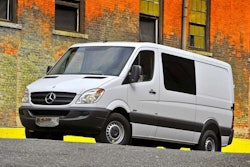 Ford’s Robot Test Drivers
Ford’s Robot Test Drivers
Human drivers replaced by robotic controls; road tests can compress 10 years of daily driving abuse into courses just a few hundred yards long
- Ford is first automaker to develop robotic technology that drives vehicles during new accelerated high-impact on-road and off-road durability testing
- Robotically driven vehicles ideally suited for durability test conditions that could prove too taxing for human drivers
Drivers jumping in and out of test trucks making repeated laps around a test track. Just another day at the proving grounds. For some maybe. But not at Ford.
Ford engineers have developed the industry’s first robotic test driving program – now in use at the company’s Michigan Proving Grounds in Romeo, Mich. – to meet demands that Ford trucks undergo ever more strenuous Built Ford Tough testing with greater frequency.
The pilot program has been used most recently for durability testing of Ford’s all-new full-size Transit van, which launches in 2014.
 Ford uses robotic control modules installed in the test vehicle to control steering, acceleration and braking.
Ford uses robotic control modules installed in the test vehicle to control steering, acceleration and braking.
“Some of the tests we do on our commercial trucks for North America are so strenuous that we limit the exposure time for human drivers,” says Dave Payne, manager, vehicle development operations.
“The challenge is completing testing to meet vehicle development time lines while keeping our drivers comfortable.
“Robotic testing allows us to do both,” he says. “We accelerate durability testing while simultaneously increasing the productivity of our other programs by redeploying drivers to those areas, such as noise level and vehicle dynamics testing.”
The durability technology includes a robotic control module installed in the test vehicle that controls vehicle steering, acceleration and braking.
The module is set to follow a preprogrammed course, and the vehicle’s position is tracked via cameras in a central control room and GPS accurate to plus/minus one inch.
Should the vehicle stray from its programmed course, engineers have the ability to stop the vehicle, course correct as necessary, and restart the test.
 Ford engineer “overseeing” vehicle test drivers.
Ford engineer “overseeing” vehicle test drivers.
Onboard sensors can command a full stop if a pedestrian or another vehicle strays into the path.
The robotically driven vehicles are expected to repeatedly perform tests on torturous surfaces with names like Silver Creek, Power Hop Hill and Curb Your Enthusiasm.
The tests can compress 10 years of daily driving abuse into courses just a few hundred yards long, with surfaces that include broken concrete, cobblestones, metal grates, rough gravel, mud pits and oversized speed bumps.
All North American Ford trucks must pass this battery of durability tests before they’re certified for customer use.
Until now, testing speeds and repetitions for specific scenarios were limited due to restrictions placed on human drivers, who were allowed to drive certain rigorous courses only once a day.
The use of robots now accelerates this testing, allowing an unlimited number of repeats until Ford engineers are satisfied with the results. Robots also allow Ford to develop even more challenging durability tests to build tougher trucks.
Ford engineers worked with Utah-based Autonomous Solutions Inc. to design and manufacture the software and components that enable autonomous, robotic operation of the test vehicle.
“We’re very excited to work with Ford for autonomous vehicle testing,” said Mel Torrie, CEO of Autonomous Solutions Inc.
“The reliability, durability and performance enhancements we’ve developed with Ford will not only help them reach their safety and accuracy goals, but will also improve vehicle automation in other areas such as mining, agriculture and the U.S. military.”
Ford engineers designed and deployed the robotic technology with two goals in mind: protecting human drivers and engineering Ford trucks to be tougher than ever.
“The goal here was not to develop a truly autonomous vehicle that can drive itself on city streets,” said Payne.
“Our objective was to create a test track solution that allows for this type of intense testing that could take our vehicles to the most extreme limits of their engineering while ensuring the safety of all involved.”
# # #








